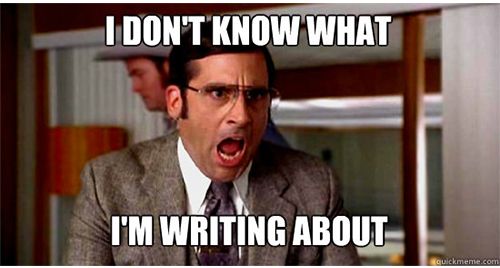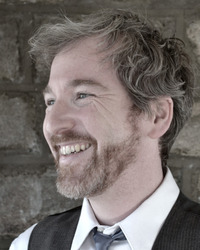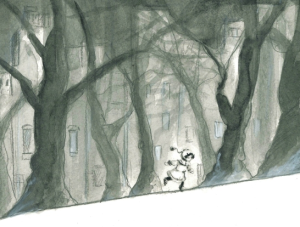–
Welcome to “One Question,” the world’s laziest interview series. In today’s edition, we’re interested in origin stories — or the origins of story — those interstices of time between books. An author casts about, open-minded and perhaps a little lost, wondering what in the world that next book might be. And then, hmmm, like a fish nibbling on a line . . . something appears.
My thanks to Matt Tavares, Tony Abbott, Keely Hutton, Greg Neri, and Aimee Reid for their contributions.
–
Matt Tavares
–
–
Tony Abbott
Different motives begin a new book for me. Denis Ever After began when I read a single word in the newspaper. It was “Toms.” I don’t recall now whether it was a piece about Toms toothpaste, or some other reference, but the idea of their being two “Toms” in the same family — brothers — started me thinking about twins. Almost immediately after birth the first boy, already named Tom, succumbed, so when the second came out, and lived, they named him Tom, as a sort of remembrance. Thus . . . Toms. The story changed leagues from that, but that’s how it began. Origins are one of the most pleasurable parts of writing for me. The whole universe of story seems capable of being encompassed in a new novel. This new story will be about love, dreams, oak tables, stars, dust, shoes, the rings of Saturn, hot chocolate, and the Gulag. Only when the pages pile up do its contours shrink and define. So. No shoes, no prison camp, and more joy than first imagined. Anyway, a way of saying reality seeps in. In my new novel, The Great Jeff, coming in March, it was the chance “sighting” of a character from a book published a dozen years ago. I’ve written about this before, but it’s probably true of all writers (and, they hope, their readers), that characters live beyond the book in some place and time, and that a story written about them is by no means all that that character is. So I saw a boy in a library, alone, reading, and I was convinced that this boy was Jeff, from Firegirl (2006). He’d reappeared, and I had to write about him. That’s how it happened. I hope it happens again. There’s something deeply satisfying in knowing that these people we seem to create are, once born, living on and on.
–
Keely Hutton
I never know when inspiration for my next book will strike, but I’m always on the lookout for subjects that spark my imagination. The spark for my upcoming middle grade novel, Secret Soldiers, started with some confusion while I binge-watched the BBC show “Peaky Blinders” two years ago. The main character, Tommy Shelby, runs his family’s criminal organization in 1919 England and suffers from PTSD due to his time as a soldier in WW1. My editor and I agreed that my next book should be in the same vein as my debut novel Soldier Boy, so I’d been researching wars and child soldiers. I hadn’t found anything that really grabbed my attention until I watched Tommy Shelby’s flashbacks, which showed him fighting in tunnels. I kept asking my husband, “Why are they underground?” After my third such query, my exasperated husband kindly suggested I Google it, so I did. A quick search revealed that thousands of sappers and miners tunneled beneath the battlefields of the Great War to undermine the enemy’s position and break the brutal stalemate of trench warfare. Fascinated, I researched whether any child soldiers fought in WW1 and was shocked to discover that over a quarter of a million underage British boys lied about their ages to join the war. When I learned that many of those young soldiers were used as beasts of burden on and under the battlefields, I knew I had found my next story and began researching and writing Secret Soldiers.
–
Greg Neri
My cousin the horse thief. Who would’ve thought? When I was growing up, I went to Texas once to stay on my uncle’s ranch. He had thirteen kids. Ten of them boys — strapping ranch hands and school wrestlers who liked to surprise-attack each other in the middle of the night out in the bunkhouse their dad built for them in the fields. To be a girl in that family, you had to be tough and willing to stand up for yourself. I could see that in my cousin Gail straight off the bat. She didn’t take no guff, and she could dish it out just as hard as her brothers — maybe harder. But inside, she was thoughtful and caring, and she loved horses. I had met Gail Ruffu only once when I was younger. Thirty-some years later, at a Christmas party at my parents’ house in California, I met her again. In the intervening years, I had occasionally heard tales of her exploits. The Texas part of the family, like the state of Texas itself, was always bigger than life. When I asked what she’d been up to lately, she paused and pulled me aside. “I’m a wanted woman, ya know,” she said. For the next hour and a half, she told me a whopper of a story of how she stole a thoroughbred on Christmas Eve and became the first person in 150 years to be charged with Grand Theft Horse — a case that went all the way to the California Supreme Court. When she was finished, I sat there, floored. My first thought was that would make a great book. So I wrote it.
Aimee Reid
One ordinary night, I was tucking my then 2-1/2-year-old daughter into bed. As usual, she asked what our schedule was for the next day. No matter how simple our plans—visiting the library, dropping in to playgroup, or simply playing at home—she always delighted in looking forward to them. After I shared my thoughts about what we would do together, she wiggled her whole body in delight and said, “When I grow up and you grow down . . . .” She proceeded to list the everyday activities we would do together if our roles were reversed.
Zing! Her words flew like a spark to my imagination. This is a story, I thought. Not long afterward, Mama’s Day with Little Gray was born (Random House). It is the tale of a small elephant who dreams of growing big enough to take care of his mama just as she has cared for him.
That story began by listening to my daughter. Sometimes, words for a story will surprise me and start running through my head. For an upcoming book, All the Earth (Penguin Random House, spring 2020), my brain fed me the first line of a lyrical text. Zing! Those words became a rhymed picture book about animal babies being cared for by their parents.
Ideas can come from anywhere. What the best book ideas have in common for me is that spark of recognition. Zing! Then I know: this is a story I am meant to write and share with the world.






























